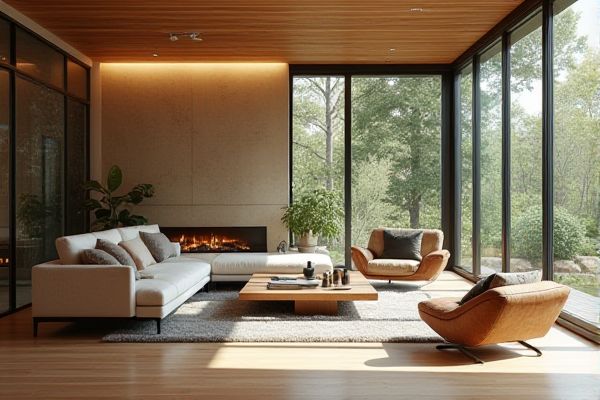
Mid-century design emphasizes clean lines, organic shapes, and functionality rooted in the 1940s-1960s era, while contemporary style embraces current trends with a focus on minimalism and innovative materials. Explore how Your space can benefit from the distinctive features of both styles by reading the full article.
Table of Comparison
| Feature | Mid-Century Modern | Contemporary |
|---|---|---|
| Time Period | 1940s - 1960s | 1990s - Present |
| Design Style | Clean lines, organic curves, minimal ornamentation | Varied; emphasizes current trends, flexible and evolving |
| Materials | Wood, teak, fiberglass, metal | Steel, glass, concrete, sustainable materials |
| Colors | Earth tones, mustard yellow, olive green | Neutral palettes, bold accents, monochrome schemes |
| Furniture | Functional, minimalist, iconic silhouettes | Innovative, ergonomic, customizable |
| Focus | Form and function balance | Adaptability and technology integration |
Understanding Mid-Century and Contemporary Styles
Mid-century style emphasizes clean lines, organic shapes, and a mix of natural and synthetic materials, reflecting design trends from the 1940s to the 1960s. Contemporary style features current design trends with an emphasis on simplicity, open spaces, and the use of modern materials like glass, metal, and concrete. Understanding these styles involves recognizing mid-century's timeless warmth and character versus contemporary's minimalist and sleek aesthetic.
Key Design Principles: Mid-Century vs Contemporary
Mid-century design emphasizes clean lines, organic shapes, and functional simplicity, often incorporating natural materials like wood and leather to create warm, inviting spaces. Contemporary design prioritizes minimalism and open spaces with neutral color palettes, using modern materials such as metal, glass, and concrete to achieve a sleek, sophisticated look. Both styles focus on functionality but diverge in their aesthetic approach, where mid-century celebrates retro charm and contemporary embraces current technological influences.
Furniture Characteristics: Classic vs Modern
Mid-century furniture features clean lines, organic curves, and tapered legs, often crafted from natural wood, emphasizing simplicity and functionality. Contemporary furniture highlights sleek, minimalist designs with bold shapes, often using metal, glass, or engineered materials to create a modern aesthetic. When choosing Your furniture, consider how mid-century pieces bring timeless warmth, while contemporary designs offer cutting-edge style and adaptability.
Popular Color Palettes in Each Style
Mid-century design features popular color palettes with warm earth tones such as mustard yellow, avocado green, and burnt orange, complemented by rich wood finishes and muted blues. Contemporary style embraces neutral hues like white, gray, and black, often accented with bold pops of color such as vibrant reds, electric blues, or bright yellows to create a sleek, minimalist aesthetic. Both styles prioritize color palettes that enhance their distinctive design elements, with mid-century leaning towards retro warmth and contemporary favoring modern sophistication.
Materials and Textures: Then and Now
Mid-century design emphasizes natural materials like teak, walnut, and leather, showcasing organic textures that evoke warmth and authenticity. Contemporary styles integrate innovative materials such as metal, glass, and engineered composites, often featuring sleek, smooth, and reflective surfaces. Your choice of textures and materials can create a distinct contrast between the timeless, tactile appeal of mid-century and the streamlined sophistication of contemporary interiors.
Architectural Elements and Layouts
Mid-century architecture features clean lines, flat planes, large windows, and open floor plans that emphasize indoor-outdoor living, often incorporating natural materials like wood and stone. In contrast, contemporary architecture showcases asymmetrical shapes, extensive use of glass, metal, and sustainable materials, with layouts designed for flexibility and maximizing natural light. While mid-century buildings prioritize simplicity and integration with nature, contemporary designs emphasize innovation, energy efficiency, and dynamic spatial arrangements.
Iconic Designers and Influences
Mid-century design is defined by icons like Charles and Ray Eames and Eero Saarinen, whose work emphasized clean lines, organic forms, and functional aesthetics inspired by the post-war optimism and modernist movements. Contemporary design draws from diverse influences, including sustainability and technology, with designers such as Patricia Urquiola and Karim Rashid shaping spaces through innovative materials and bold, eclectic styles. Your understanding of these iconic designers helps distinguish the timeless simplicity of mid-century from the dynamic and evolving nature of contemporary design.
Decor Accessories and Accents Compared
Mid-century decor accessories emphasize organic materials like teak wood, brass, and ceramic, featuring geometric patterns and minimalist designs that enhance warm, retro-inspired interiors. Contemporary accents prioritize sleek finishes, including glass, metal, and acrylic, with bold colors and abstract shapes that contribute to clean, modern aesthetics. Both styles focus on functional, statement pieces, but mid-century highlights nostalgic charm while contemporary emphasizes innovation and simplicity.
Blending Mid-Century with Contemporary Aesthetics
Blending mid-century design with contemporary aesthetics creates a timeless yet modern interior by combining clean lines, organic forms, and warm wood tones with sleek finishes and minimalist decor. Incorporating iconic mid-century furniture pieces alongside contemporary lighting and textiles enhances visual interest while maintaining functionality. This fusion prioritizes balance between vintage charm and current trends, promoting a sophisticated, cohesive living space.
Choosing the Right Style for Your Home
Mid-century design emphasizes clean lines, organic shapes, and natural materials, creating a timeless and warm atmosphere ideal for those seeking simplicity and functionality. Contemporary style highlights sleek forms, innovative materials, and a minimalist aesthetic, perfect for homeowners who prefer modern sophistication and flexibility in decor. Selecting between mid-century and contemporary depends on whether you value classic warmth or cutting-edge trends to match your lifestyle and interior space.
 homyna.com
homyna.com